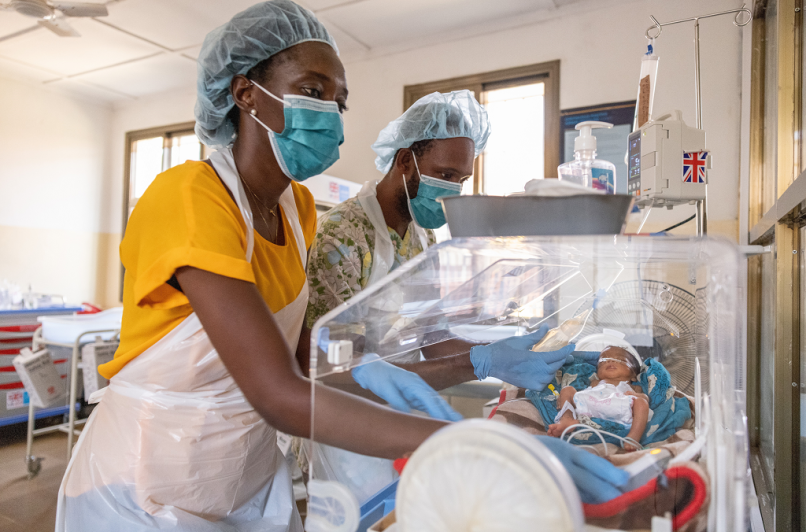New report provides in-depth analysis on healthcare electrification trends, challenges and future outlook
Electrifying healthcare facilities with sustainable energy can contribute to the improvement of health outcomes, foster innovation and broader social development, and support the fight against climate change.
However, according to the World Health Organization (WHO), an estimated 1 billion individuals across the globe currently have local healthcare facilities with an unreliable power supply. Moreover, in Sub-Saharan Africa alone, a staggering 25,000 healthcare facilities lack access to electricity entirely, while around 70,000 health centres have an unreliable electrical supply. In South Asia, 12% of healthcare facilities lack any access to electricity.
A new report released today by Sustainable Energy for All offers a comprehensive and global perspective on the healthcare electrification landscape, while also providing a practical roadmap for the evolution and sustainable advancement of this critical sector.
The State of the Market Report for Healthcare Facility Electrification presents the current state of the healthcare electrification market and includes valuable insights into the key challenges being faced by the sector; financing and investment needs; what we can expect from the sector in the coming years; and recommendations to unlock progress on powering healthcare.
What sets this study apart is its foundation in SEforALL’s Powering Healthcare Intervention Heatmap and Database, an updated version of which will go live by mid-February 2024. This is currently the most comprehensive and up-to-date source of information regarding health facility electrification covering 387 initiatives from 78 stakeholders in 89 countries. This ensures the accuracy and granularity of the analysis, offering a real-world perspective on the challenges, opportunities and best practices in healthcare electrification.
“The in-depth and holistic analysis of the healthcare electrification sector that this report provides can help stakeholders and funders gauge where their efforts and resources are needed most, so they can maximize their impact.”
Luc Severi, Programme Manager, Powering Healthcare, SEforALL
Key findings
Among the trends identified in the report is that since the onset of the COVID-19 pandemic, healthcare electrification initiatives have seen robust growth. There has been a notable focus on smaller and rural health centres and a shift towards larger, more comprehensive power solutions.
Another trend is the improving global collaboration between energy and health players, although further progress is required at the country level. Stakeholders are also beginning to realize the significance of capacity building, particularly to increase in-house capabilities within government departments.
Innovation in technology and business models is reshaping healthcare electrification. Advancements in solar PV systems, batteries and remote monitoring are making electrification projects more cost-effective and sustainable. Private sector providers are exploring the use of service-based models to ensure consistent power quality and long-term maintenance.
While substantial progress has been made in the sector in recent years, developers and donors continue to face challenges. These include a lack of institutional coordination, a lack of operations and maintenance (O&M) frameworks, inadequate understanding of the health sector’s energy needs, limited capacity at the government level and limited availability of data.
Financing healthcare electrification is another major challenge. Nearly two-thirds of global health facilities lack adequate power supply, requiring an estimated total investment of USD 4.9 billion. Current capital flows are nowhere close to the required amounts. This underscores the urgent need for innovative funding solutions.
Recommendations
Climate finance is emerging as a promising avenue in the market. Healthcare electrification can benefit from different climate finance mechanisms like dedicated funds and renewable energy certificates (RECs), and in return, ensure resilience and reduced greenhouse gas emissions. The report provides other such future projections for market-changing factors and drivers as well as challenges for the market’s continued development.
For sustainable healthcare electrification, a collaborative approach involving policymakers, the private sector and donors/investors is crucial. It is vital to develop long-term O&M plans and tailored country taxonomies, and improve inter-sectoral coordination, capacity building, champion engagement and consistent impact measurement. Such a multi-pronged strategy promises transformative change in healthcare electrification, enhancing healthcare access and community well-being.
State of the Market Report for Healthcare Facility Electrification was developed by Sustainable Energy for All in consultation with Economic Consulting Associates Limited (ECA) and Odyssey Energy Solutions. This work has been funded by UK aid from the UK government via the TEA platform https://tea.carbontrust.com/.

